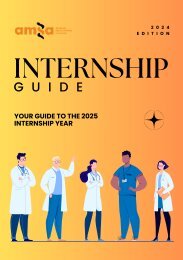Vector Volume 11 Issue 1 - 2017
You also want an ePaper? Increase the reach of your titles
YUMPU automatically turns print PDFs into web optimized ePapers that Google loves.
may perceive the risks from vaccinations to be<br />
greater than the likelihood of contracting the<br />
very diseases they prevent.[5]<br />
In fact, surveys of Australian parents show<br />
that the primary reason for vaccine hesitancy<br />
or objection is concerns about their safety[6]<br />
and a third of parents believe children are<br />
over-vaccinated. Newer vaccines, like the<br />
HPV vaccine, can be perceived to have<br />
a lower risk-benefit ratio, as they protect<br />
against diseases that are less prevalent or<br />
virulent. Older vaccines also face doubts, as<br />
the diseases they prevent are less common<br />
or even eliminated in the Australia, such as<br />
measles. Furthermore, concerns about adverse<br />
reactions to vaccination are growing. This could<br />
be attributed to the fact that such reactions<br />
are perceived to be more common than the<br />
diseases that they prevent.<br />
Common misconceptions regarding vaccines<br />
Rare but severe adverse reactions to<br />
some vaccinations attract great public<br />
interest, and give rise to misconceptions or<br />
over-estimations regarding their harms. For<br />
instance, the 1955 Cutter Incident in the USA<br />
involved administration of 380,000 doses of<br />
incompletely inactivated polio vaccinations to<br />
healthy children, which resulted in 40,000 cases<br />
of abortive polio (a minor form that does not<br />
involve the central nervous system), 51 cases<br />
of permanent paralysis and five deaths. It also<br />
started a polio epidemic, leaving even more<br />
people in the community affected.[7]<br />
This event severely undermined public<br />
confidence in the safety of vaccinations, even<br />
after it prompted the instigation much safer<br />
and stricter regulation of vaccines.[7] Incidents<br />
such as this undermine trust in vaccine safety,<br />
and these fears must be addressed in the<br />
community.<br />
Commonly, anti-vaxxers also claim that while<br />
they are not against vaccinations themselves,<br />
they oppose the adjuvants and preservatives<br />
that are potentially harmful, like thiomersal.<br />
However, studies have not been able to identify<br />
any harmful effects related to thiomersal, and<br />
even so, it was removed from all Australian<br />
childhood vaccines.[8]<br />
One of the most infamous controversies<br />
surrounding vaccine safety was Andrew<br />
Wakefield’s retracted 1998 paper that linked<br />
the Measles, Mumps and Rubella (MMR)<br />
vaccine to autism and bowel disease. His study<br />
was severely flawed, involving a sample of only<br />
12 children, and Wakefield was deregistered<br />
and discredited. In comparison, a Danish<br />
retrospective cohort study investigated over<br />
500,000 children who received the MMR vaccine<br />
and proved that there was no association<br />
between the vaccine and autism.[9] Despite<br />
this, many of the general public still believe in<br />
the association between the MMR vaccine and<br />
autism as a consequence of Wakefield’s study.<br />
Vaccine objection in the context of Australian<br />
vaccination policies<br />
As of January 2016, the nationwide legislation<br />
called “No Jab No Pay” has been put into<br />
effect, removing conscientious objection from<br />
exemption criteria to immunisation requirements<br />
for Centrelink childcare payments worth up to<br />
$19,000. A press release by then Prime Minister<br />
Tony Abbott and Health Minister Scott Morrison<br />
stated that “the choice made by families not<br />
to immunise their children is not supported by<br />
public policy or medical research nor should<br />
such action be supported by taxpayers in the<br />
form of child care payments”.[10]<br />
In contrast, public health experts believe that<br />
this policy is may be misplaced in its aims to<br />
reduce conscientious objection to vaccination,<br />
rather than addressing the more prominent<br />
barriers of access to services, logistical<br />
issues, and missed vaccination opportunities.<br />
[<strong>11</strong>] A policy such as this could also threaten<br />
the validity of a patient’s informed consent,<br />
which is outlined in the Australian Immunisation<br />
Handbook as being “given voluntarily in the<br />
absence of undue pressure, coercion or<br />
manipulation”.[12] This has generated a fresh<br />
6

















